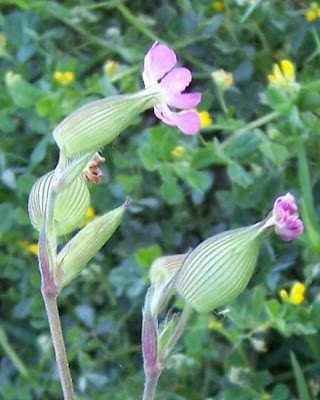Viscaria atropurpurea
(Viscaria atropurpurea)

Description
Viscaria vulgaris (Synonyms: Silene atropurpurea), the sticky catchfly or clammy campion, is a flowering plant in the family Caryophyllaceae. It is an upright perennial growing to 60 cm (24 in) in height. The leaves are lanceolate. The flowers, which are 20 mm across and bright rosy-pink, appear in long whorled spikes from May to August. It grows on cliffs and rocky places. The Latin name Viscaria means "sticky", and refers to the stickiness of the stem just below the leaf joints. The English common names reference the same feature. Viscaria vulgaris is also grown as an ornamental garden plant. In British horticultural literature it is often referred to by its synonym Lychnis viscaria. The cultivar 'Splendens Plena', a double-flowered form, has won the Royal Horticultural Society’s Award of Garden Merit. Silene is a genus of flowering plants in the family Caryophyllaceae. Containing nearly 900 species, it is the largest genus in the family. Common names include campion and catchfly. Many Silene species are widely distributed, particularly in the northern hemisphere. Members of this genus have been the subject of research by preeminent plant ecologists, evolutionary biologists, and geneticists, including Charles Darwin, Gregor Mendel, Carl Correns, Herbert G. Baker, and Janis Antonovics. Many Silene species continue to be widely used to study systems, particularly in the fields of ecology and evolutionary biology. The genus has been used as a model for understanding the genetics of sex determination for over a century. Silene species commonly contain a mixture of hermaphroditic and female (or male-sterile) individuals (gynodioecy), and early studies by Correns showed that male sterility could be maternally inherited, an example of what is now known as cytoplasmic male sterility. Two independent groups of species in Silene have evolved separate male and female sexes (dioecy) with chromosomal sex determination that is analogous to the system found in humans and other mammals. Silene flowers are frequently visited by flies, such as Rhingia campestris. Silene species have also been used to study speciation, host-pathogen interactions, biological species invasions, adaptation to heavy-metal-contaminated soils, metapopulation genetics, and organelle genome evolution. Notably, some members of the genus Silene hold the distinction of harboring the largest mitochondrial genomes ever identified.
Taxonomic tree:







